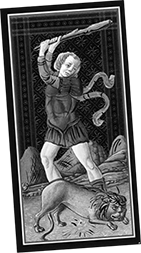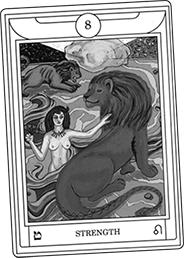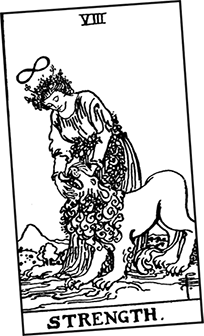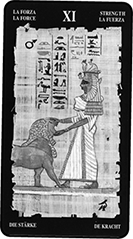Strength: 8
Astrological correspondence: Leo
Kabbalistic letter: ![]() Teth
Teth
Path on Tree of Life: Chesed (Mercy) to Gevurah (Power)
The first thing to say about Strength is that for many people it does not belong here at all. In the Tarot of Marseille, and for many modern Tarotists, card eight is Justice and Strength is card eleven.The Golden Dawn reversed the order, largely because Leo (the lion) seemed to go with Strength and Libra (scales) with Justice. In the order of the signs, Leo comes before Libra, with Virgo (a good choice for the Hermit) coming between them. Waite, a Golden Dawn leader at one point, followed this order, so that most people now think of Strength as eight.
Strength cards from Visconti, Marseille, Rider, Golden Dawn Ritual, Egyptian & Shining Tribe






For myself, I find it valuable to see Strength as the initiator of the second level and Justice as the midpoint, not just of the line, but of the entire Major Arcana. In my approach to Tarot, meaning counts more—trumps, we might say—than systems. While I find the Golden Dawn order most meaningful, I also see value in the older tradition. If we see cards eight through fourteen as a search for our true selves, then Justice can symbolize the desire that moves us to begin, Strength the quality we need in the middle of this process. On the other hand, while the desire for truth may motivate us, we need a great deal of inner strength to begin such a process. We turn away from the Chariot’s willpower and find the courage to look inward. After the initial explorations, we come to the center of looking at our lives and balance the scales.
In the Middle Ages and Renaissance, Strength, also called Force, or Fortitude, meant one of the four cardinal virtues. In medieval thought, this meant subduing or overcoming the passions, especially sexual desire. The lion symbolized “animal” desires. We might think of someone who struggles with some unacceptable urge—to have an affair, maybe, or to steal, or give in to an addiction—and contains this desire through self-discipline. Some older versions of Fortitude showed the hero Hercules clubbing a lion to death (the first of his twelve labors). The image of the woman who closes the lion’s mouth (some people say she opens it, others that she gets the lion to speak) shows us a different way to subdue the passions, through trust. Still, the goal remains the same: overcoming desire. Aleister Crowley challenged this idea by naming his Strength card “Lust” and showing the woman riding the lion, her nude body exultant.
We should recognize that people in the Middle Ages sometimes saw lions in a much more positive sense. As the “king of beasts,” and golden like the sun, the lion symbolized Christ, the golden light of existence for Christian mystics. At least two modern fantasies use this kind of imagery. C. S. Lewis’s children’s book The Lion, the Witch, and the Wardrobe has a Christlike lion king who dies and is resurrected. Charles Williams, author of the Tarot novel The Greater Trumps, used the lion for the archetype of majesty in his mystical thriller The Place of the Lion. In Williams’s novel, the world becomes endangered when a powerful meditation unwittingly allows the Platonic Ideals to take physical existence in the bodies of animals escaped from a circus. At the end, the hero takes on the role of Adam, the archetypal human, and names the beasts, causing the archetypes to retreat. The human overcomes the lion with the power of speech, an image of Strength.
We might think of this card as the quality of naming, and thus understanding, nature. Older generations might have seen it as a symbol of agriculture and civilization, taming the wilderness. Today we might think of it more as ecology, in which the human and the natural worlds exist harmoniously. Notice in the Rider version the way the flower belt on the woman extends gently around the lion’s neck.
So much of this symbolism accepts the idea of Strength as subduing desire. For many people, the picture shows a simpler quality, the appreciation of your own strength, self-confidence. We can talk of inner strength, believing in yourself without having to control or dominate others. And since I do not see passion as something dangerous (or sinful!), I used the image of an untamed lioness in my own version of this card. The Shining Tribe Strength comes from a Persian medallion of a griffin, a winged lion. While some have seen the posture as defensive, I tend to think of the lioness reaching for the future while looking to the past. She is rooted in the earth but can move into the unknown.
Because people’s ideas of Strength vary so much (both the quality and the card), I decided to poll various Tarotists for their views. To my surprise, quite a few kept the idea of subduing or conquering desire. Avigayil Landsman, who writes about the spiritual and divinatory meanings of the Hebrew letters, quoted the line, “Who is strong? He who is in control of his passions.” Johanna Gargiulo-Sherman, creator of the Sacred Rose Tarot, said that the spiritual prevails over the physical, and the animal instincts give way to doing “the right thing.”
The question is, how do we know what is right if it goes against our instincts? The Hierophant might tell us to follow his doctrines, the Emperor to obey his rules. But if we see the Tarot overall as a model for self-development, the question becomes trickier—and tricks put us in the realm of the Magician. Maybe we could think of merging with our desires, or our desires raised up, so that right action, personal will, and divine will become the same.
Megan Williams, a Tarotist from Australia, takes what I think of as a more modern approach. Strength is an inner quality, feminine, built of self-love and trust. In readings, she thinks of building trust, showing love. Numerologist Carey Croft describes it as the quality that allows you to do something not easy but necessary, in alignment with your higher self. It can signify strength of mind, of spirit, and the ability to focus. Joan Pantesco, who also goes by the name of Purple, focused on the lion, or rather the relationship between the male lion and the woman. Strength for her is androgyny, a blend of masculine and feminine.
Avigayil Landsman, mentioned above, took a fascinating view of the lion, describing the woman as a midwife and the lion a cervix the woman helps to open. Feminine Strength becomes the power of women to give birth. This idea might help explain a very ancient connection of goddesses and lions. One of the earliest carvings, some eight thousand years old, shows a powerfully built woman seated in a chair, with the “crown” of a baby emerging from between her legs. Female lions, or leopards, crouch on either side of her. Various Middle Eastern goddesses were shown with lions, and in the Chariot we described how the Romans celebrated Cybele, Great Mother of the gods, by having her black meteorite carried in a chariot drawn by lions. Cybele came from the same area in western Turkey, Anatolia, as that seated goddess thousands of years earlier.
Laura Triana stressed the esoteric tradition around Strength. The Hebrew letter Teth means a snake, and thus the kundalini energy that rests like a coiled snake at the base of the spine. Usually we experience kundalini as sexual, but it can travel up the spine and transform to spiritual enlightenment.
The snake also represents the life force, which occultists recognized as spiraling energy long before the discovery of DNA as a double helix. Her number 8 can look like a spiral.
Artist and Tarot reader Paige Vinson said to her the card meant closeness to animals. Zoe Matoff took that a step further to suggest animal communicators, people who use knowledge and psychic connections to find what specific animals need to say to the humans around them. Or it could mean listening to your own animal nature.
Now that we have seen what people today think of Strength, what about early cartomancers?
Some Strength Meanings
Excerpted from Mystical Origins of the Tarot by Paul Huson.
Pratesi’s Cartomancer (1750): Violence.
De Mellet (1781): Fortitude, who comes to the aid of Prudence by vanquishing the lion, the wild, uncultivated land.
Court de Gébelin (1773-82): Force or Strength.
Lévi (1855): The Hebrew letter Kaph, Strength. The hand in the act of grasping and holding.
Christian (1870): Arcanum XI. The Tamed Lion: Strength. In the divine world, the Principle of all strength, spiritual or material; in the intellectual world moral Force; in the physical world organic Force.
Mathers (1888): Strength, or Fortitude. Power, might, force. Reversed: Abuse of power, overbearingness, want of Fortitude.
Golden Dawn (1888-96): Daughter of the Flaming Sword, Leader of the Lion. Fortitude, courage, strength, power not arrested in the act of judgment, but passing on to further action, sometimes obstinacy.
Grand Orient (Waite, 1889, 1909): Fortitude, or Strength. Courage, vitality, tenacity of things, high endurance.
Waite (1910): Fortitude. Power, energy, action, courage, magnanimity, success and honors. Reversed: Despotism, abuse of power, weakness, discord or disgrace.
Pratesi begins with violence, possibly in response to that image of Hercules clubbing a lion. De Mellet sees the woman “vanquishing” the lion, who symbolizes wild nature. Paul Christian, Mathers, and the Golden Dawn all stress power. So does Waite, as both Grand Orient and himself.
So where does that idea of gentleness come in, of feminine passion? Maybe it literally comes from women, and modern women at that, the many who have helped shape Tarot interpretation over the last three or four decades. One of the earliest of these modern interpreters was Eden Gray, author of several Tarot books in the late 1960s and early ’70s. Here is what she says about Strength:
Force of character, spiritual power overcoming material power, love triumphing over hate, the higher nature over carnal desires. Reversed: Domination of the material. Discord, lack of moral force, fear of the unknown in ourselves, abuse of power.
With all these possibilities, what should we say when Strength shows up in a reading? More than most other cards, it can depend on what the quality means to the querent. When you look at this card—and make sure you really look at it—think of how you understand strength, and if you are reading for someone else, ask that person.
Is it the power to withstand life’s struggles? Overcoming your animal nature? Working with your animal self? A person who literally works with animals—a vet, a trainer, or an animal communicator? Does the lion mean desire or sexuality, and if so, what is the woman’s relationship to it?
My own first meaning for this card calls for people to realize their own strength, especially in situations where they believe themselves inadequate. Depending on the question and the other cards, it can indicate a need for strength. In my experience, the Tarot does not just say “This would be a good idea.” If a card appears as something a person needs, it also says the person can find this in herself.
Strength does not necessarily recommend any particular action. Sometimes it means the strength to do nothing. The other cards may indicate what, if anything, needs to be done. Strength tells you that you have the ability to do what is needed.
Reversed might mean the desires unchecked, giving in to temptation, especially sexual. Is that necessarily a bad thing? Past generations thought so. Now opinions differ. But if the other cards show some danger from reckless behavior, then we might worry about unchecked desire.
In my experience with Strength reversed, I think first of weakness, or a person who doubts her or his own strength. If someone faces a difficult task or is involved in a longstanding, difficult situation, upside-down Strength can show a feeling of “I can’t do this.” The other cards may indicate that the person actually does have more resources than she or he knew, more inner courage or resolve. But maybe not. Maybe “weakness” is not a judgment but a description of the situation. Reversed Strength may warn us against trying to do something that cannot be done.
And is weakness necessarily a bad thing? Too often we endure bad conditions just because we can—because we can take it or because someone else is weak and we need to be strong. Once in a reading we asked, “What is the best thing the person can do right now?” We were surprised to see Strength reversed appear. After a moment, I realized it told the person, “Let yourself be weak. Let someone else carry the burden.”
A Strength Reading
1. How am I strong?
2. How am I weak?
3. When do I need to be strong?
4. When do I need to be weak?
5. What strengthens me?
6. What weakens me?